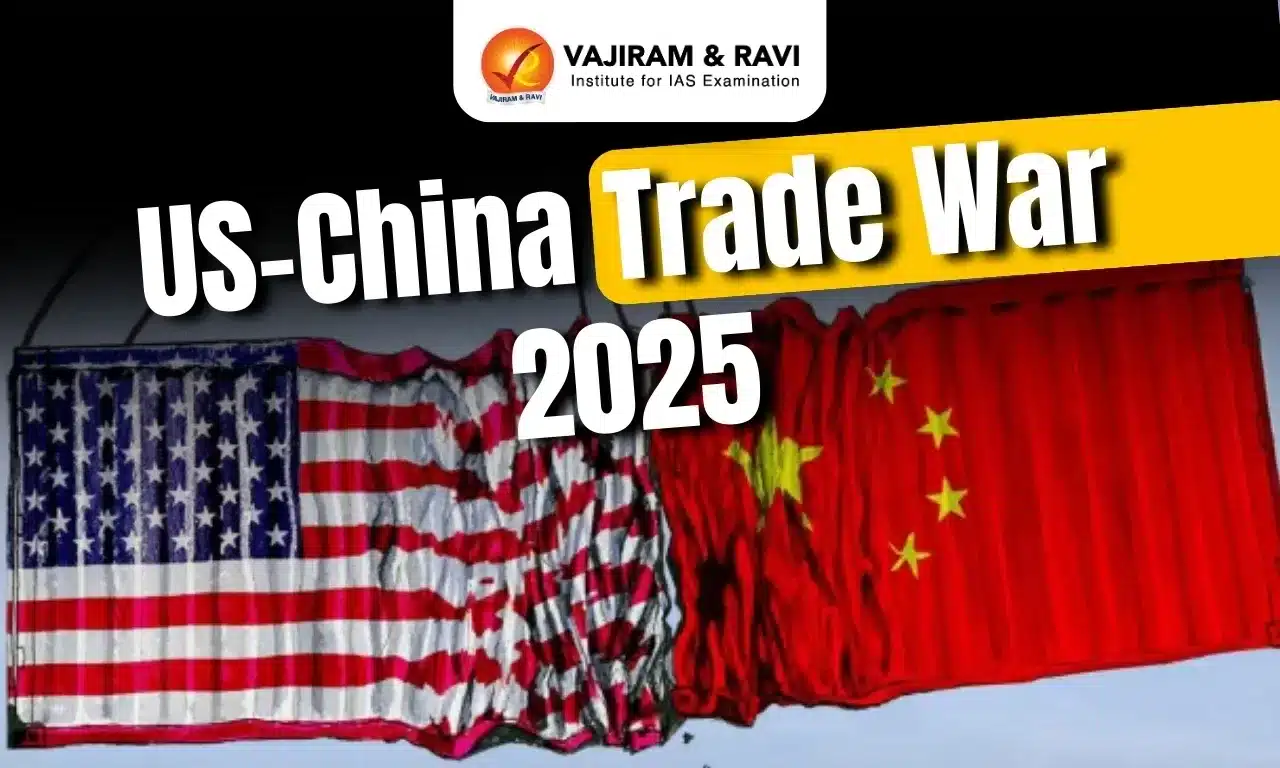What’s in Today’s Article?
- US-China Trade War 2025 Latest News
- A Brewing US-China Trade War
- US-China Trade Snapshot
- Escalating Tariff War
- Leverage in the Trade War – A Comparison
- Problems with Tariffs
- US-China Trade War 2025 FAQs
US-China Trade War 2025 Latest News
- President Donald Trump temporarily suspended most tariffs for 90 days amid a global market crisis, while sharply increasing tariffs on Chinese imports to 125%. This move appeared to shift the broader trade conflict into a direct U.S.–China standoff.
- The countries included in the tariff pause will now face a reduced 10% tariff, as the U.S. plans individual negotiations with each nation.

A Brewing US-China Trade War
- A full-scale trade conflict is looming as President Trump threatens over 100% tariffs on Chinese goods, effectively creating a trade embargo.
- This move could spark a dangerous decoupling between the world’s largest economies.
The Critical Question
- The critical question remains: will these measures hurt China more than the US?
- While Trump is open to negotiations with other countries, the long-term impact of this policy gamble is still uncertain.
US-China Trade Snapshot
- Total trade between the US and China stood at $582.4 billion in 2024.
- US exports to China: $143.5 billion (↓2.9% from 2023)
- US imports from China: $438.9 billion (↑2.8% from 2023)
- US experiences a trade deficit of approx. $295 billion, around 1% of US GDP, contrary to Trump’s exaggerated $1 trillion claim.
Escalating Tariff War
- Both countries remain unwilling to back down. China vows to “fight to the end” and has imposed retaliatory tariffs.
Immediate Consequences of Tariffs
- High costs could make imports from China prohibitively expensive.
- The US may struggle due to dependence on Chinese goods, including:
- Critical drug ingredients
- Rare earth elements (vital for defense tech)
- High-end consumer products
- Washington might be forced to find alternative suppliers or reduce consumption.
US Strategy: Delay with China, Engage the Region
- The US is prioritizing talks with Japan, South Korea, and others in China’s neighborhood.
- A negotiation with Beijing may come later, if at all.
Beyond Tariffs: Core Trade Concerns
- The main US grievances extend beyond tariffs:
- Currency manipulation: China keeps the renminbi undervalued to boost exports.
- Non-tariff barriers: Restrictions on foreign firms in sectors like consumer banking and high-end manufacturing.
Leverage in the Trade War – A Comparison
- The US imports far more from China than vice versa, giving it nominal leverage.
- Meanwhile, China’s economy still depends heavily on exports due to weak domestic consumption.
China’s Strategic Advantages
- Political Stability – Unlike Trump, Xi Jinping faces no elections or significant internal opposition.
- Economic Planning – China is rolling out a stimulus package combining fiscal and monetary measures.
- Long-Term Strategy – Beijing can continue fiscal stimulus longer and strengthen domestic consumption, which could absorb surplus if exports dip.
US Weaknesses and Political Pressure
- Consumer Impact – Americans rely on Chinese imports for everyday essentials – clothing, shoes, electronics. Tariff costs are passed on to consumers, especially affecting low-income groups.
- Limited Fiscal Tools – Washington has few options left other than extending Trump-era corporate tax cuts.
China’s Internal Narrative and Xi’s Image
- The Chinese view the trade war as US bullying, and Xi cannot afford to appear weak.
- Domestic rhetoric and nationalism make it harder for China to back down unless the US makes a move first.
Problems with Tariffs
- Tariffs: Difficult to Roll Back
- Tariffs imposed by Trump during his first term remained under Biden and were even increased.
- Once implemented, tariffs tend to become permanent, making them hard to dismantle politically.
- Little Economic Benefit to the US
- A major academic study found that Trump’s tariffs did not significantly impact employment, including in steel plants.
- Retaliatory tariffs by China and others hurt American farmers, with job losses in agriculture.
- Global Market Implications
- A prolonged trade war could push China to redirect exports to new markets.
- There’s a high chance that China will dump surplus goods in the EU and India, affecting local industries there.
US-China Trade War 2025 FAQs
Q1. Why did the US increase tariffs on China in 2025?
Ans. To pressure China amid trade tensions; Trump aims to isolate China while negotiating individually with other trade partners.
Q2. What is the new US tariff rate on Chinese goods?
Ans. The US raised tariffs on Chinese imports to 125%, effectively creating an embargo-like trade barrier.
Q3. How much is the US trade deficit with China?
Ans. The US trade deficit with China stands at approximately $295 billion, about 1% of US GDP.
Q4. What are the risks of these tariffs to the US?
Ans. US consumers face higher prices, especially for essentials; the economy lacks tools to offset tariff-driven inflation.
Q5. What are China’s strengths in the trade war?
Ans. China has political stability, strong economic planning, and room for prolonged fiscal stimulus to counter export losses.
Last updated on June, 2025
→ UPSC Notification 2025 was released on 22nd January 2025.
→ UPSC Prelims Result 2025 is out now for the CSE held on 25 May 2025.
→ UPSC Prelims Question Paper 2025 and Unofficial Prelims Answer Key 2025 are available now.
→ UPSC Calendar 2026 is released on 15th May, 2025.
→ The UPSC Vacancy 2025 were released 1129, out of which 979 were for UPSC CSE and remaining 150 are for UPSC IFoS.
→ UPSC Mains 2025 will be conducted on 22nd August 2025.
→ UPSC Prelims 2026 will be conducted on 24th May, 2026 & UPSC Mains 2026 will be conducted on 21st August 2026.
→ The UPSC Selection Process is of 3 stages-Prelims, Mains and Interview.
→ UPSC Result 2024 is released with latest UPSC Marksheet 2024. Check Now!
→ UPSC Toppers List 2024 is released now. Shakti Dubey is UPSC AIR 1 2024 Topper.
→ Also check Best IAS Coaching in Delhi













